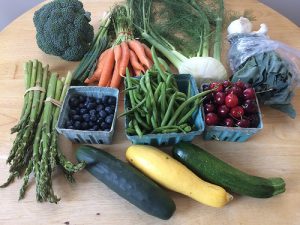What Shopping Strategies Can You Use for Fat Loss and Lean Muscle?
Your decision to change your grocery shopping habits will prevent you from making bad decisions when you find yourself home alone on the couch watching “Game of Thrones” with no other options but Bon-Bons and Ben & Jerry’s.
One of the safest strategies you may ever use for improving your nutrition to further enhance your health, fitness, and body composition (i.e. here, increasing or maintaining muscle tone while decreasing body fat in various areas) is prevention.
Would you be more likely to adhere to your diet or “cave in” with four open sleeves of Oreos sitting on your counter or only vegetables, fruits, and lean meats as options in your kitchen?
Now, you do always have the option to go to your nearby McDonalds or Burger King for a double cheeseburger, fries, and of course, a Diet Coke.
But how much time do you invest in driving to fast food restaurants, spending extra money, and potentially hindering your goals of attaining better health, fitness, and body composition?
Seeing that you are reading this article, you must already be invested in your own self-improvement and are ready to take steps toward a positive change in your nutrition and lifestyle.
Congratulations!
Let us make it easier on you to stick with your nutrition plan. We will start with six steps to lessen the chances of tempting foods ever making it to your pantry or refrigerator.
…at least until Grandma shows up to your home unannounced with a tray full of freshly-baked cookies.

Stop smiling, Grandma.
This all starts with grocery shopping.
Before taking your next trip to the grocery store, follow this step-by-step guide to improve your grocery shopping habits for better health, fitness, and body composition.
1. Purchase Groceries for Only One Week
Buying groceries for only one week will lessen your chances of coming home with unnecessary items or amounts of food.
The less food available in your kitchen, the less likely to indulge in food items intended for the following week(s).
The more suited your grocery list is to the demands of your upcoming week, the more likely you will be to save money and your nutrition plan.
To start creating your grocery list, first determine your schedule and activity level for the upcoming week.
Will you have higher levels of physical activity this week or will you be predominately sitting or unable to exercise for most of the week?
Plan your week ahead, identifying and planning the exact amount of times you can schedule to exercise along with the duration (length), intensity (difficulty level), and the frequency (number of times) of your workout sessions.
The recommended exercise guidelines here are at least five (5) times per week for 30-60 minutes. The ranges listed are largely dependent upon the intensity of your workout sessions.
Some weeks may entail higher frequencies, intensities, and a longer duration of physical activity (i.e. movement from activities of daily living that require energy including gardening, moving furniture, cleaning) and/or exercise (i.e. planned and structured physical activity with the goal of improving health and fitness).
Other weeks may require less energy and your groceries should be adjusted accordingly.
Set a goal this week to perform your workouts as scheduled and customize your shopping list to fit your level of activity for the upcoming week.
If you schedule less exercise throughout the week, consider buying less starchy carbohydrates (i.e. potatoes, rice, pasta) and natural sugar sources (namely, fruits) and increase your amount of vegetables.
If you plan to exercise more throughout the week, consider adding more additional carbohydrate sources for your exercise days including starchy carbohydrates and natural sugars, while still maintaining an emphasis on vegetables.
2. Create Your Grocery Shopping List
Create your grocery list before heading to the store and have your list ready to refer to while shopping.
You can select from the three categories below of protein, carbohydrates, and fats to help you select your groceries for your upcoming week.
Certain foods such as fruits, oils, nuts, and vegetables are listed with examples to condense the shopping list options to simplify your selection.
Each item is still included in the suggested number of food items to start with from each category of between three and five. Also, while several carbohydrates are listed, I recommend to aim for their whole grain alternatives unless you are intolerant or allergic.
Start by selecting between three and five food items from each category:
Protein:
Bison
Eggs
Chicken
Lean Ground Beef
Cottage Cheese
Milk
Pork
Turkey
Cod
Salmon
Pork
Greek Yogurt
Tilapia
Turkey
Cod
Salmon
Tuna
Veggie Burger
Tofu
Tempeh
Beans/Legumes
Carbohydrates:
Vegetables (Examples: Spinach, Lettuce, Celery, Zucchini)
Fruits (Examples: Apples, Berries, Bananas, Oranges)
Oats
Bread
Pasta
Rice
Potatoes
Fats:
Eggs
Nuts (Examples: Almonds, Cashews, Brazilian Nuts, Mixed Nuts)
Various Butters (Examples: Cashew Butter, Peanut Butter, Almond Butter)
Oils (Examples: Coconut Oil, Olive Oil, Fish Oil)
Avocados
Various Seeds (Examples: Chia Seeds, Sunflower Seeds, Pumpkin Seeds)
Note: This list is not intended to cure any disease(s) and/or health problem(s). If you have any health complications and/or food allergies, please consult with a qualified healthcare physician and registered dietitian.
Once you have completed your grocery list, starting with three to five foods from each category, aim to adhere to shopping for only the foods you selected.
3. Eat Before Grocery Shopping
Before grocery shopping, consume a full meal complete with protein, carbohydrates, and fats.
Grocery shopping can be difficult when hungry.
Have you ever walked into a grocery store hungry to find yourself looking for food to satisfy your immediate hunger?
You may find yourself opening a tub of Ben & Jerry’s in the middle of the aisle when you meant to leave with a bag full of vegetables.
4. Set a Timer
Time your next grocery visit to 30 minutes or less to prevent buying unnecessary items.
Timing your grocery visit helps minimize the chances of purchasing more food.
Furthermore, the longer you spend in the grocery store, the more likely to spend more money and pick up food not on the grocery list.
The 30 minute or less recommendation does not need to be exact and you are not expected to sprint around the grocery store with your shopping cart pretending to be a contestant on “The Amazing Race”.
There is no need to start shoving innocent shoppers out of the way to retrieve your items unless they have the last discounted package of bison.
The takeaway is to practice getting in and out of the store with the appropriate groceries.
Ready? Set? Go!
5. Shopping the Perimeter
Start shopping outside of the center aisles, which is more likely to have a healthier selection including vegetables, fruits, dairy, and lean meats.
When shopping the perimeter, you are more likely to find foods that are more conducive to improving your nutrition for your enhancing your health, fitness, and body composition.
The middle aisles are typically where you may find items including potato chips, sodas, and ice cream.
However, there also may be some food items in the middle aisles that are on your grocery list such as rice, pasta, and oats (largely recommended for post-workout nutrition).
While it is OK to quickly grab some items from the middle aisles, aim to spend the majority of your time shopping outside of these aisles.
6. Adjust Food Quantities
Adjust your amount of grocery foods based on exercise schedule and overall activity level for the week.
If you planned your exercise schedule for the week and you are largely sitting throughout the week with a few days of exercise, opt for more vegetables and fruits (emphasis on vegetables) and less from other carbohydrate sources.
Aim to select the highest quality of foods that are the least expensive at quantities that are within your budget.
Check the weekly advertisement of your local grocery store while making your shopping list and adjust accordingly to what is on sale and least expensive.
Again, the more specific your grocery list is to your weekly schedule, the less likely to eat and spend more than was intended.
Grocery shopping can be a simple process to help you adhere to your nutrition plan for improving health, fitness, and body composition. Start your grocery shopping with this step-by-step guide by:
- Purchasing groceries for one week;
- Creating your grocery shopping list;
- Eating before shopping;
- Setting a timer;
- Shopping the perimeter;
- And adjusting your food quantities.
The next time you plan on grocery shopping, try incorporating this step-by-step guide.
Feel free to leave any comments below if you or a friend have any questions.
-J











